Pointillism – A Quick Way, Step by Step!
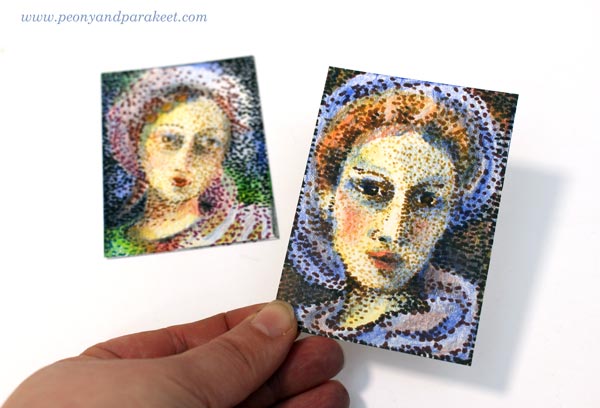
I am honored to be one of the guest artists in Documented Life Project this month. I was given a theme (pointillism) and a project type (artist trading card, ATC). As long as I followed those, I could do anything with any supplies. These kind of challenges are fun because you get such enough restrictions to get started but can still create freely. However, I have one fixation with artistic trading cards. I like them to be portraits, either humans or animals.(See ATCs in this post, for example!) So I chose a very traditional subject, women from the past.
Pointillism Can Be Tedious!
Like most of us, I have always admired Georges Seurat‘s paintings. In the 1980s, a Finnish illustrator made images that were composed of small points. It might have been an artist called Osmo Omenamäki. As a teenager, inspired by him and Seurat, I decided to be a pointillist artist too. I picked my felt-tipped pens and started to draw dots. Oh my! I was barely able to finish a postcard size drawing. I couldn’t believe how many small dots are needed to fill even a small blank area! I was almost traumatized by that experience!
So now, over 30 years later, I didn’t even think about creating the project with felt-tipped pens only. ATCs are small, but not that small! However, with felt-tipped pens, it is easy to make intentional tiny dots in a variety of colors. But I also needed something else to make the coloring faster. Colored pencils leave the spots visible, and they are easy to control. So I chose them to fill the blanks between the dots.
Practicing – Spots with Many Colors
Before the actual project, I practiced my ideas. I made the dots using a variety of colors and then added more colors with colored pencils.

Because the colors in dots weren’t as important as coloring with colored pencils, I got an idea of using brown shades only. It would be like an underpainting, a technique that old masters often used in portraits. They painted shadows with umber and then applied the rest of the colors so that the shadows showed through. So I will show you how you can do a similar kind of “under-dotting” and then apply the actual colors with colored pencils!
1) Under-Dotting with Felt-Tipped Pens
You will need four shades of felt-tipped pens for this step. I use Faber-Castell PITT Artist Pens in colors “Light Flesh”, “Green Gold”, “Raw Umber” and “Caput Mortuum”. I didn’t use any model like a photo but just created intuitively, making the features more accurate color by color.
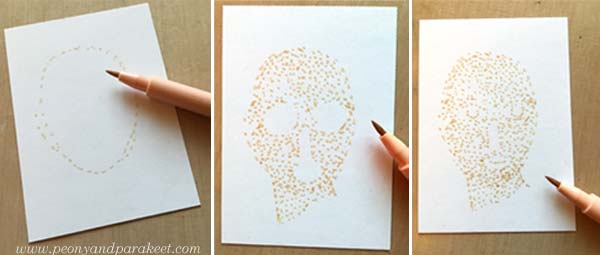
With the palest of color, sketch an oval using small dots. The liberating thing here is that when you start with a pale color and make little dots, you can make many “mistakes” and correct them as you go. One spot in a wrong place can be easily changed! Fill the oval with dots so that you leave blank space where you plan mouth, eyes, and nose to be. When they seem to be in place, add some dots for details. Don’t worry if your woman looks pretty ugly. This is just the first layer!
Change to darker shades and add shadows to the face. Then sketch the hair and clothes using little dots only.
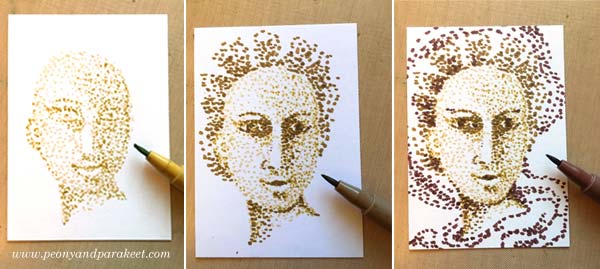
Every shade adds a little bit more to the image.
2) Basic Coloring with Black and Colored Pencils
Now add black spots to the darkest of details. Old portraits often had a dark background, so I added black spots there too.
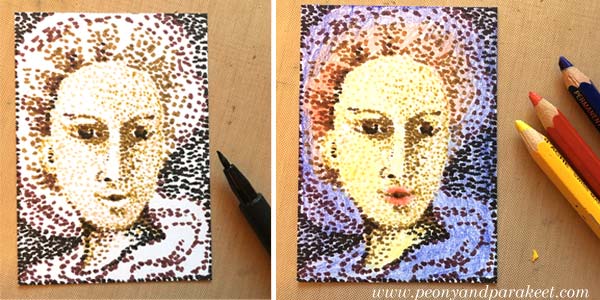
Using colored pencils, color the card so that white shows only where you want to have it in the end. I used Caran d’Ache Pablo pencils in blue, red and yellow. Remember that you can mix colors by layering. You can get many beautiful tones from the primary colors.
3) More Liveliness with Colored Pencils
Finally, add shadows so that the details look 3-dimensional. If you only have primary colors like I had, you can get a dark background by adding blue, red and yellow layers there. If your portrait looks too dark, use an eraser to lighten and soften the colors.
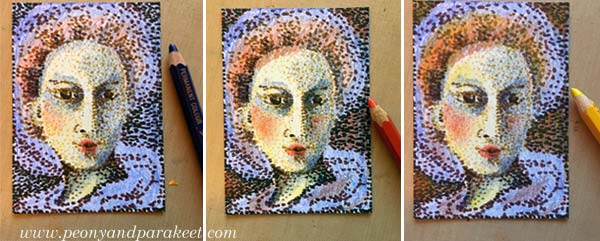
In the end, check the facial features of your woman. Add small lines where you want to turn the attention. Don’t draw the lines near the nose but on the lips and the eyes.
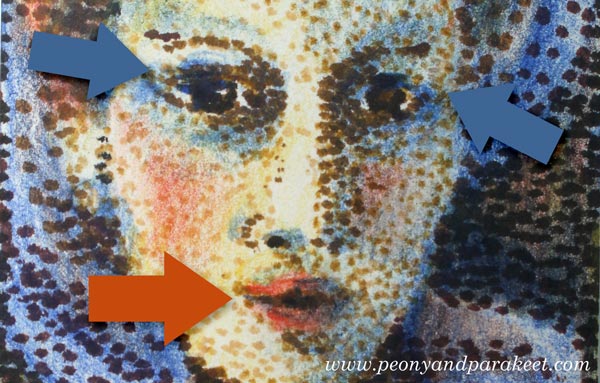
Celebrating Blurriness
Here are my finished cards again. I think they look delightfully blurry!
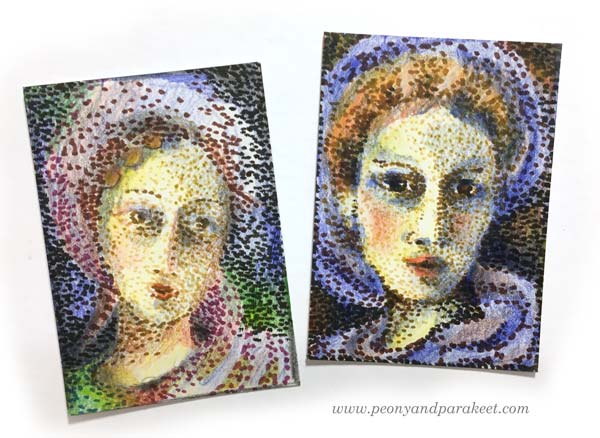
The more I want to reduce stiffness in my art, the more I feel the need to embrace blurriness. With blurriness, I also feel more self-acceptance, more ease with errors, more open to possibilities.
Reducing stiffness is one of the main themes in my newest class too. The class is called Inspirational Drawing 2.0 and it’s about drawing from imagination and inspiration. Watch the introductory video below!
Inspirational Drawing 2.0: Liberate your line and sign up now!
Moleskine Sketchbook – Another Full Art Journal!

I just finished my red Moleskine Sketchbook. It always feels like an accomplishment when an art journal gets full. So I’m happy to show a couple of photos and a flip-through video of all the pages!
Moleskine Sketchbook as an Art Journal
Moleskine Sketchbooks are one of my favorite books for art journaling. The paper is sturdy, and it can be used with a variety of supplies. I use mostly watercolors, acrylic paints, colored pencils and PITT artist pens. But I also use inks, gel pens, hand-decorated papers for collages, etc. The small size is handy for quick pages and easy to put in a bag. However, sometimes the size is a little bit too small, especially for acrylic paintings. So I also use other journals, especially large Dylusions Creative Journals. The paper is very smooth, so it’s not ideal for watercolors. But I don’t mind that too much, I use a little less water to make watercolors work with the paper. Some prefer coarser paper for colored pencils but I love how effortless it is to color the pages in Moleskine Sketchbook.
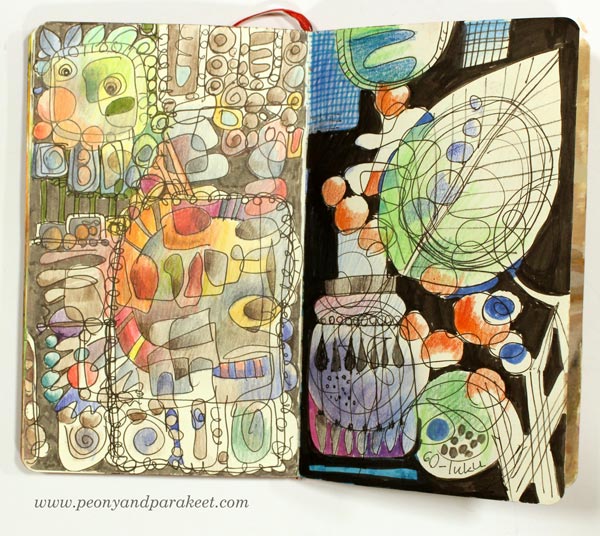
The Purpose of an Art Journal
For me, art journals are little more than just sketchbooks. I like to call them “idea books” as I often process my ideas further when I am working on the page. I don’t always make one page on the same go, but work with it several times, adding more ideas as the page progresses. However, I have quite low expectations on how my pages will look. They are not pieces of art but more like collections of ideas to me.
As you can see from the flip-through video, my ideas are often connected to art history and different styles. The first photo of this blog post shows a spread inspired by Rococo. The second photo shows a spread that I made after browsing designs from the 1960s. Even if I sometimes write short stories or make notes about my current thoughts, I mostly write about beautiful things that I have seen and visualize the ideas I have gotten from it.
My art journals are not chronological diaries but random visual notes that I process to full images. I can make a quick sketch of a rose one day and then continue the page with painting on the other day. When I am working with a new art class, I use art journals to record my visual ideas and practice the techniques. I also see creating art journal pages a route to bigger paintings. When I paint on canvas, I use the ideas that I have come up with when making the pages. Every artist should also be an art journaler!
Flip-Through Video
Create Step by Step!
I have gathered all the most popular free step-by-step instructions and all my flip-through videos on a separate page. Go to Create Step by Step!
Creative Struggles in the Middle of Possibilities

Here’s an art journaling spread that I made for Imagine Monthly Fall. It’s a part of November’s mini-course called Patterned Topiary. For the mini-course, I chose three main themes for the inspiration:
1) Gustav Klimt, the famous artist, and especially his Golden Phase pieces
2) playing with patterns and repeats
3) topiary art, the art of cutting trees and shrubs into shapes. As Gustav Klimt has brilliant portraits, I also included a woman there.
Predictions and Creative Struggles
Some time after creating the mini-course, I started the renaissance painting technique class under Emmi Mustonen. Now when I look at my work (which is still in progress), I see the same woman appearing there. It’s like art could predict the future!

The two projects are very different and still – it’s easy to see that the person who created the first image, the art journaling spread, is the same who’s painting the copy of the portrait. I think this is a brilliant example of why we shouldn’t put ourselves in one corner, but be always willing to learn new perspectives. I could have said that I love freedom and won’t go to the class that is “just copying.” Or the vice versa: that I value old masters so much that I won’t combine them with mixed media techniques or with less-valued art forms like cutting trees. I might have avoided some creative struggles, but I would also have missed the possibilities.
My second project for November’s mini-course is also like a prediction.
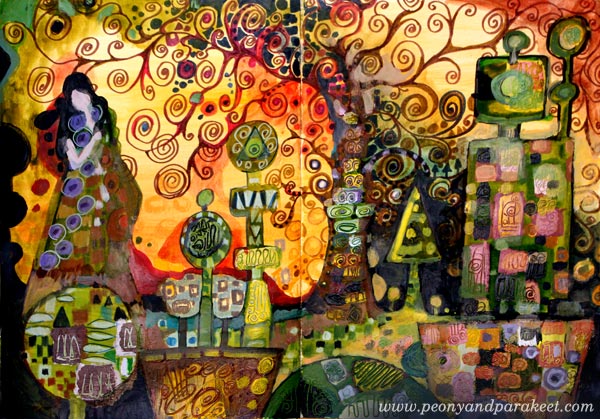
Namely, last Saturday, I went to see Yayoi Kusama‘s exhibition at Helsinki Art Museum. Another celebration of dots and patterns!
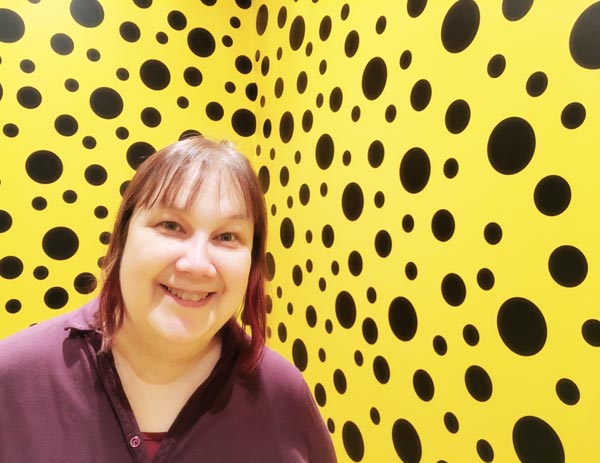
Diversity of Themes and Techniques
I have now released 4 of 5 mini-courses for my art journaling master-class Imagine Monthly Fall 2016. There’s a lot of diversity in the projects: painting, drawing, making collages and combining the techniques to create mixed media art. You can still sign up and get all the published mini-courses immediately. There’s also a great community that you don’t want to miss! Seeing many versions of monthly themes is part of the enjoyment! I also lead a discussion related to the theme every month.
Struggles in the Middle of Possibilities
When creating and teaching the mini-courses, I have experienced that art is full of possibilities but still, we fight with the fixations all the time. To me, the word “artist” has so much emotional overload that it feels difficult calling myself one.
But I got a wake-up call recently when someone said to me: “You’re already an artist and you should just embrace that. Doing otherwise is denying who you are.”
Selling My Art in Public!
After pondering that, I decided that I have to stop selling secretly based on occasional requests. I should make my art more accessible. So I set up a shop at Saatchi Art, which is a commercial site for artists. The great thing about Saatchi Art is that you can now also order fine art prints from my pieces, not only buy originals. Some of the paintings are sold already, but you can buy them as prints.
Tell me, which struggles do you have with your creating right now? Are they due to a certain technique, certain conditions or a certain mindset?
Start Drawing from Stick Figures!
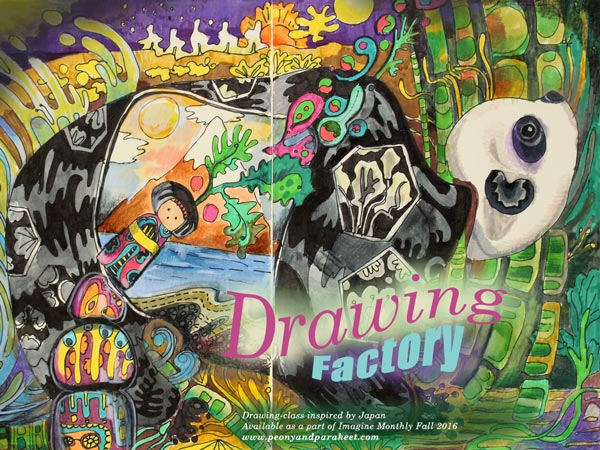
If you browse my blog posts this fall, you would think that I have been painting only. But no, I have drawn too! I’m really happy about my recent mini-course that is available as a part of Imagine Monthly! It’s called Drawing Factory as it’s about drawing efficiently no matter what your current drawing skills are. Plus it’s inspired by Japan, the land of high-production factories and fascinating culture.
Drawing ATC Cards
I got the idea for the mini-course in summer when I got the urge to draw a series of ATC cards.
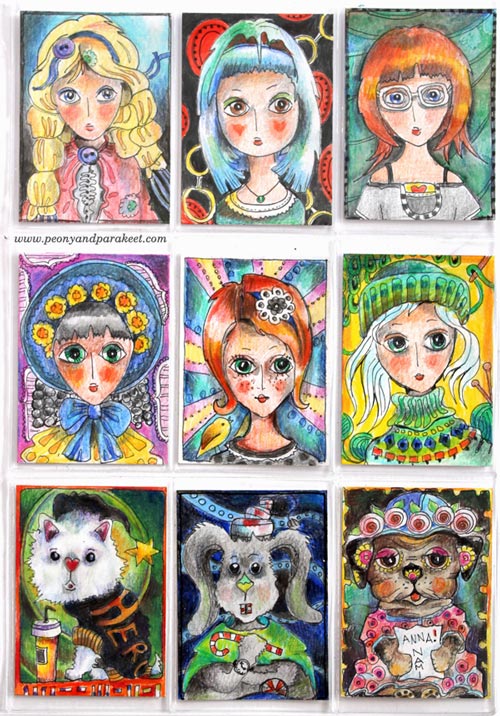
I had so much fun drawing these! While drawing, I thought about how much people use stamping instead of drawing in ATC cards. I felt liberated without them, drawing freely. How could I make hand-drawing more attractive and enjoyable?
Drawing with the Help of Stick Figures
Along drawing this big bunny art journal spread, I developed a series of tips and tricks about how you can create imaginative line drawings without tedious sketching.
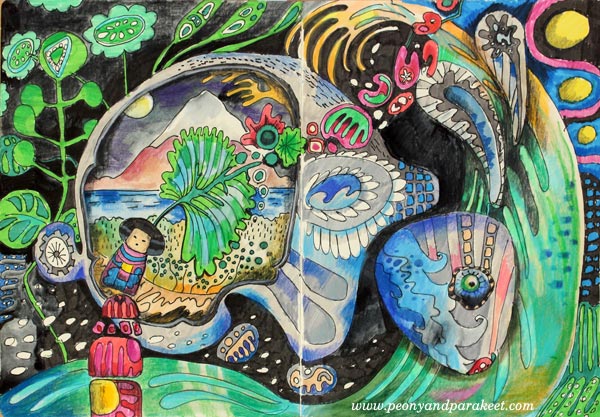
My method is based on stiff lines as people often say: ” I can only draw a stick figure!” But sticks can be an answer, not a problem!
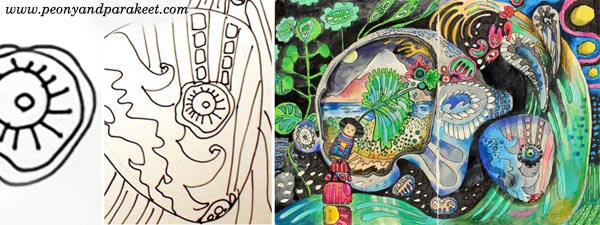
The panda is the project that I am creating in the class video. The video also includes a drawing lesson where I show how to build drawings, or should I say rich illustrations, based on simple lines.
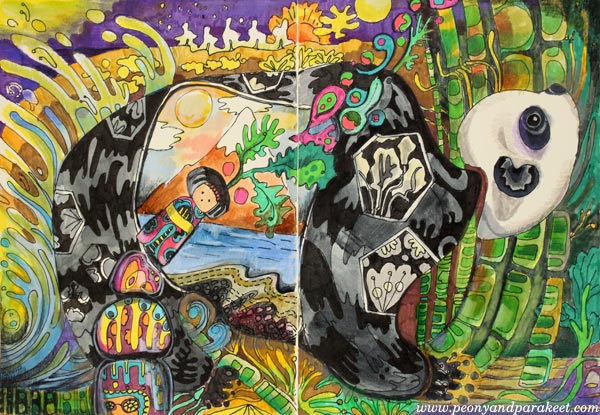
Buy Drawing Factory!
Drawing Factory is now available as an individual self-study class: Buy Now!

